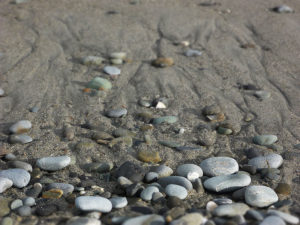 This meditation is based on four lines in Tetazveh (Exodus 28:9-12) instructing the creation of two stone shoulder fasteners for the high priest’s Ephod (see postscript). Called avnei zikaron, remembrance stones, the fasteners were engraved with the names of the 12 tribes. Here are three alternative uses: use it as a Jewish prayer (shown here); others may focus on their own religion; or it can be used as a universal prayer, including all teachers of faith and peace, from rabbis to Sufis, from Budda to Mother Teresa.
This meditation is based on four lines in Tetazveh (Exodus 28:9-12) instructing the creation of two stone shoulder fasteners for the high priest’s Ephod (see postscript). Called avnei zikaron, remembrance stones, the fasteners were engraved with the names of the 12 tribes. Here are three alternative uses: use it as a Jewish prayer (shown here); others may focus on their own religion; or it can be used as a universal prayer, including all teachers of faith and peace, from rabbis to Sufis, from Budda to Mother Teresa.
Stones of Remembrance
Whose names
Will you engrave upon your shoulders
When you stand before G-d
In prayer?
Whose names
Will you carry in your heart
As you sing songs
Of blessing and praise?
G-d,
Remember us in the name of
Our ancestors: ________________________.
[Add meaningful names from Biblical times to the Second Temple, for example: Abraham, Miriam, Nachshon, Zilpah, etc.]
G-d,
Remember us in the name of
Our sages: ________________________.
[Add names from the Second Temple to contemporary times, for example: Yochanan ben Zaki, Regina Jonas, etc.]
G-d,
Remember us in the name of
Our teachers: ________________________.
[Add names from the contemporary period, for example: a scholar, teacher, author or friend.]
These are the stones of remembrance,
The righteous and the driven,
The certain and the seeker,
The women and the men
Who have led Your people,
Taught Your Torah,
And rallied congregations and assemblies
To Your service.
Let my name,
One day,
Be worthy.
Let my life
Become a tribute
To your wondrous works,
A remembrance of Your gifts
Throughout the generations.
© 2015 Alden Solovy and tobendlight.com. All rights reserved.
Postscript: See also: “Sages,” “Tabernacle” and “The Statutes of Heaven.” The Ephod was an apron covering the tunic and robe and served as the place where the Choshen, the breastplate, was fastened. The Soncino (Hertz) commentary says the engravings were to remind the people of their unity in the service of G-d; the Stone (Scherman) commentary says that they reminded G-d of the righteousness of the people. The two concepts are inseparable. By remembering those who came before us in prayer, we remind both G-d of the righteous among us and ourselves of our unity before G-d.
Please consider making a contribution to support this site and my writing. For usage guidelines and reprint permissions, see “Share the Prayer!” For notices of new prayers, please subscribe. You can also connect on Facebook and Twitter.
Photo Source: WikiMedia Commons
Tags: prayer for our teachers, remembering our ancestors, sages prayer, Torah, wisdom, תורה, תצוה